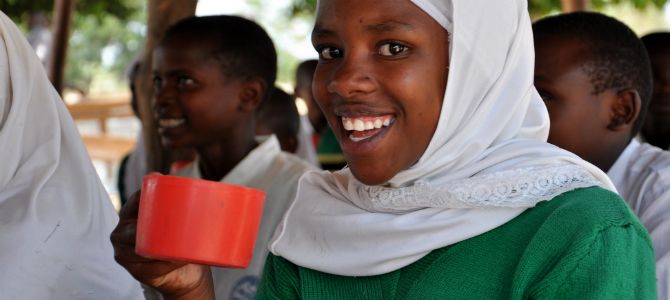
United Republic of Tanzania
Current issues and what the World Food Programme is doing
Tanzania stretches inland over 945,000 km square from Africa’s eastern seaboard; it includes the semi-autonomous Indian Ocean archipelago of Zanzibar.
Historically poor, but with a record of peace and stability, the country has attracted people fleeing civil strife elsewhere in the region. The Tanzanian economy has grown strongly in recent years, driven by telecommunications, financial services, transport and construction; the discovery of large oil and gas reserves holds the promise of increased revenue. But with four-fifths of its nearly 52 million people dependent on subsistence agriculture, Tanzania remains one of the world’s least developed countries. One Tanzanian in 3 is illiterate; nearly 3 in 10 are poor.
Although the country is self-sufficient in food, reliance on the rain and traditional farming techniques means households, districts and regions may suffer food shortages. While the liberalization of exports has turned Tanzania into a regional grain supplier, domestically, high rates of malnutrition persist.
Current issues in Tanzania
• Tanzania's latest National Nutrition Survey (2014) has found 34.7 percent of children under five to be stunted.
• The maternal mortality rate, while improving, remains high at 398 deaths per 100,000 live births. Poor maternal health can be attributed to many factors, including inadequate access to, and utilization of, health services. As a result, healthy foetal growth is hindered, and mothers are susceptible to complications in pregnancy and child birth.
• The vast majority of Tanzanians are reliant on subsistence farming; this makes them vulnerable to climatic, economic and seasonal shocks.
• Three camps in north-western Tanzania house large numbers of refugees from neighbouring countries. WFP assistance is their main source of food.
What the World Food Programme is doing in Tanzania
Through its Market Access, Food for Assets, Nutrition, School Meals and Refugee support activities, WFP reaches half a million Tanzanians in chronically food-insecure regions.
• Under its Market Access initiatives, WFP connects the demand for crops with commercial markets. Through our Patient Procurement Platform (PPP), we help farmers transition from subsistence farming to market-oriented agriculture. Under PPP, private buyers are guaranteed pre-planting forward delivery contracts, which open access to credit and agricultural inputs necessary to plant and harvest quality crops. This boosts farmers’ incomes and long-term resilience.
• WFP's Food Assistance for Asset Creation programme aims to stimulate economic growth at household level. Investment in irrigation schemes, dams and market access roads strengthens farmers' resilience to climate change, improves the productive potential of the farmland and increases household incomes.
• WFP is the only agency in Tanzania to provide supplementary food rations to pregnant and breastfeeding women and children under five. The emphasis is on the regions of Dodoma and Singida, which have high rates of stunting and wasting.
• In 2015, WFP launched a Home Grown School Feeding pilot programme to enable districts and schools to manage school meals by procuring food locally from smallholding farmers. Currently implemented in two districts, the programme reaches almost 25,000 students.
• WFP provides a food basket of Super Cereal (fortified blended food), pulses, vegetable oil, and salt to nearly 200,000 refugees in the camps of Nyarugusu, Nduta and Mtendeli. The rations meet a minimum dietary requirement of 2,100 Kcal per person per day.
• With most of the eight neighbouring countries landlocked and facing humanitarian situations, Tanzania serves as a crucial logistical link for WFP operations in the region. Furthermore, the port of Dar es Salaam is a trans-shipment point for operations in Somalia. Tanzania is also one of eight nations to pilot the One UN initiative, under which UN agencies (including WFP) work together to “deliver as one” at country level.
World Food Programme partners in Tanzania
WFP cannot fight global hunger and poverty alone. These are our partners in Tanzania:
• Adventist Development and Relief Agency (ADRA)
• Bahi District Council
• Building Rural Income Through Enterprises (BRITEN)
• Bunda District Council
• CARITAS Kigoma
• CEFA Tanzania Registered Trustees
• Chamwino District Council
• Childreach Tanzania
• Danish Refugee Council
• Good Neighbours Tanzania
• Igunga District Council
• Ikungi District Council
• International Rescue Committee (IRC)
• Kwimba District Council
• Magu District Council
• Misungwi District Council
• Nzega District Council
• Private Agricultural Sector Support (PASS)
• Project Concern International
• Relief to Development Society (REDESO)
• Rural Urban Development Initiative (RUDI)
• Singida Rural District Council
• Tanzania Water & Environment Sanitation (TWESA)
• World Vision Tanzania
All images Copyright: WFP/Jen Kunz
Featured Tanzania publications
-
Tanzania: WFP Country Brief (PDF, 463 KB)
A Country Brief provides the latest snapshot of the country strategy, operations, operational highlights (achievements and issues/challenges), partnerships and country background.
-
Tanzania: WFP Situation Report
A Situation Report is a concise operational document with latest updates on the World Food Programme's (WFP) response to an emergency. It gives an overview of WFP’s activities and informs the wider humanitarian community and other interested stakeholders about WFP’s response.
Looking for more publications on Tanzania? Visit the Tanzania publications archive.


